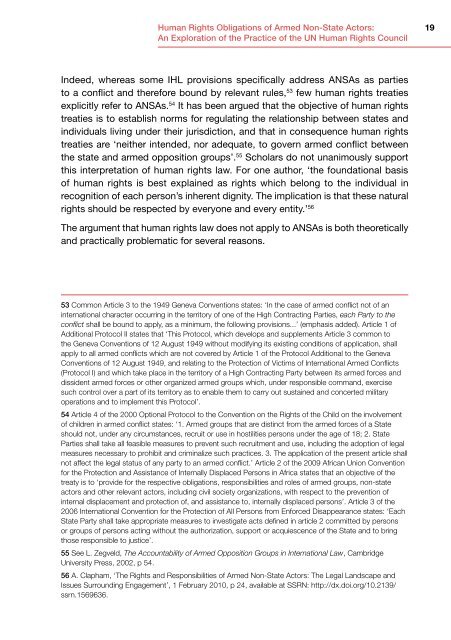InBrief7_web
InBrief7_web
InBrief7_web
Create successful ePaper yourself
Turn your PDF publications into a flip-book with our unique Google optimized e-Paper software.
Human Rights Obligations of Armed Non-State Actors:<br />
An Exploration of the Practice of the UN Human Rights Council<br />
19<br />
Indeed, whereas some IHL provisions specifically address ANSAs as parties<br />
to a conflict and therefore bound by relevant rules, 53 few human rights treaties<br />
explicitly refer to ANSAs. 54 It has been argued that the objective of human rights<br />
treaties is to establish norms for regulating the relationship between states and<br />
individuals living under their jurisdiction, and that in consequence human rights<br />
treaties are ‘neither intended, nor adequate, to govern armed conflict between<br />
the state and armed opposition groups’. 55 Scholars do not unanimously support<br />
this interpretation of human rights law. For one author, ‘the foundational basis<br />
of human rights is best explained as rights which belong to the individual in<br />
recognition of each person’s inherent dignity. The implication is that these natural<br />
rights should be respected by everyone and every entity.’ 56<br />
The argument that human rights law does not apply to ANSAs is both theoretically<br />
and practically problematic for several reasons.<br />
53 Common Article 3 to the 1949 Geneva Conventions states: ‘In the case of armed conflict not of an<br />
international character occurring in the territory of one of the High Contracting Parties, each Party to the<br />
conflict shall be bound to apply, as a minimum, the following provisions...’ (emphasis added). Article 1 of<br />
Additional Protocol II states that ‘This Protocol, which develops and supplements Article 3 common to<br />
the Geneva Conventions of 12 August 1949 without modifying its existing conditions of application, shall<br />
apply to all armed conflicts which are not covered by Article 1 of the Protocol Additional to the Geneva<br />
Conventions of 12 August 1949, and relating to the Protection of Victims of International Armed Conflicts<br />
(Protocol I) and which take place in the territory of a High Contracting Party between its armed forces and<br />
dissident armed forces or other organized armed groups which, under responsible command, exercise<br />
such control over a part of its territory as to enable them to carry out sustained and concerted military<br />
operations and to implement this Protocol’.<br />
54 Article 4 of the 2000 Optional Protocol to the Convention on the Rights of the Child on the involvement<br />
of children in armed conflict states: ‘1. Armed groups that are distinct from the armed forces of a State<br />
should not, under any circumstances, recruit or use in hostilities persons under the age of 18; 2. State<br />
Parties shall take all feasible measures to prevent such recruitment and use, including the adoption of legal<br />
measures necessary to prohibit and criminalize such practices. 3. The application of the present article shall<br />
not affect the legal status of any party to an armed conflict.’ Article 2 of the 2009 African Union Convention<br />
for the Protection and Assistance of Internally Displaced Persons in Africa states that an objective of the<br />
treaty is to ‘provide for the respective obligations, responsibilities and roles of armed groups, non-state<br />
actors and other relevant actors, including civil society organizations, with respect to the prevention of<br />
internal displacement and protection of, and assistance to, internally displaced persons’. Article 3 of the<br />
2006 International Convention for the Protection of All Persons from Enforced Disappearance states: ‘Each<br />
State Party shall take appropriate measures to investigate acts defined in article 2 committed by persons<br />
or groups of persons acting without the authorization, support or acquiescence of the State and to bring<br />
those responsible to justice’.<br />
55 See L. Zegveld, The Accountability of Armed Opposition Groups in International Law, Cambridge<br />
University Press, 2002, p 54.<br />
56 A. Clapham, ‘The Rights and Responsibilities of Armed Non-State Actors: The Legal Landscape and<br />
Issues Surrounding Engagement’, 1 February 2010, p 24, available at SSRN: http://dx.doi.org/10.2139/<br />
ssrn.1569636.


